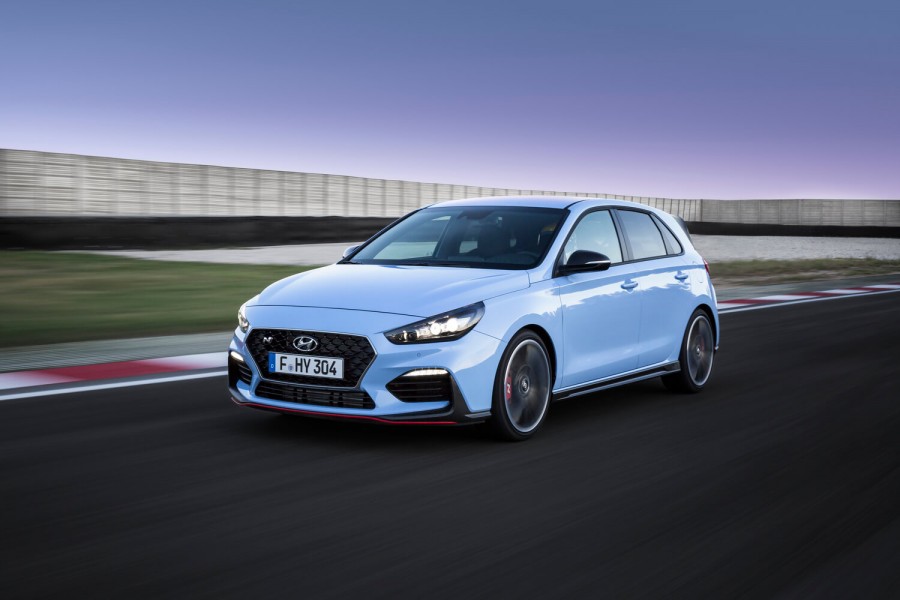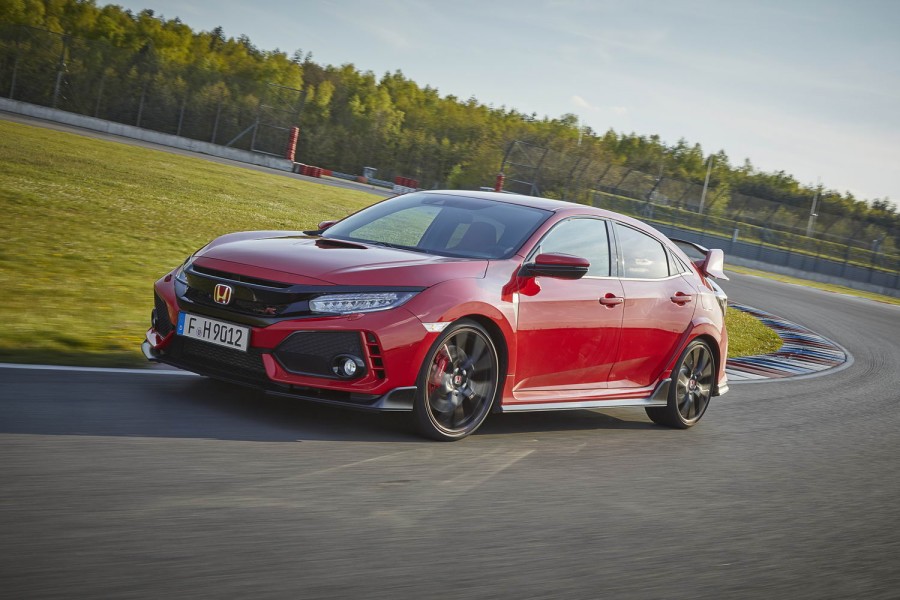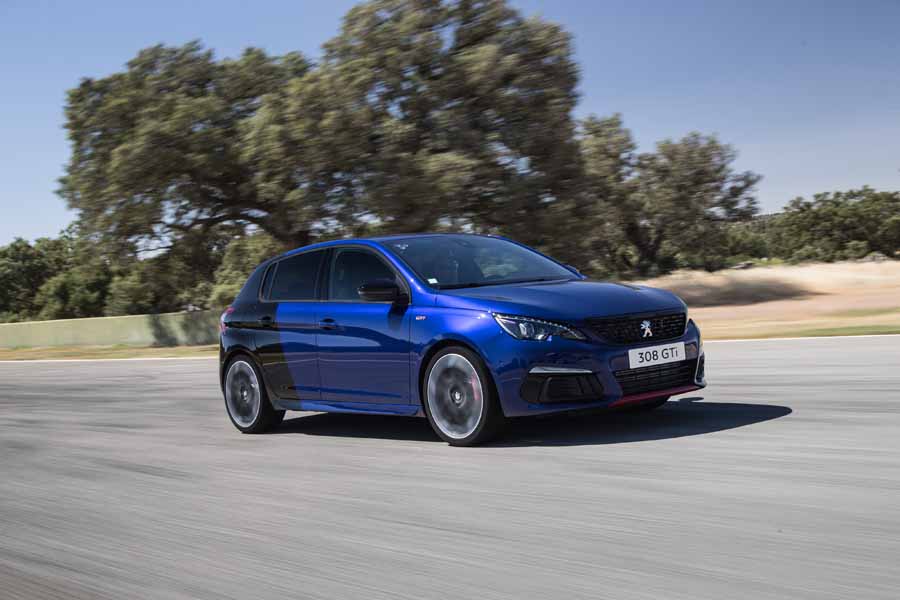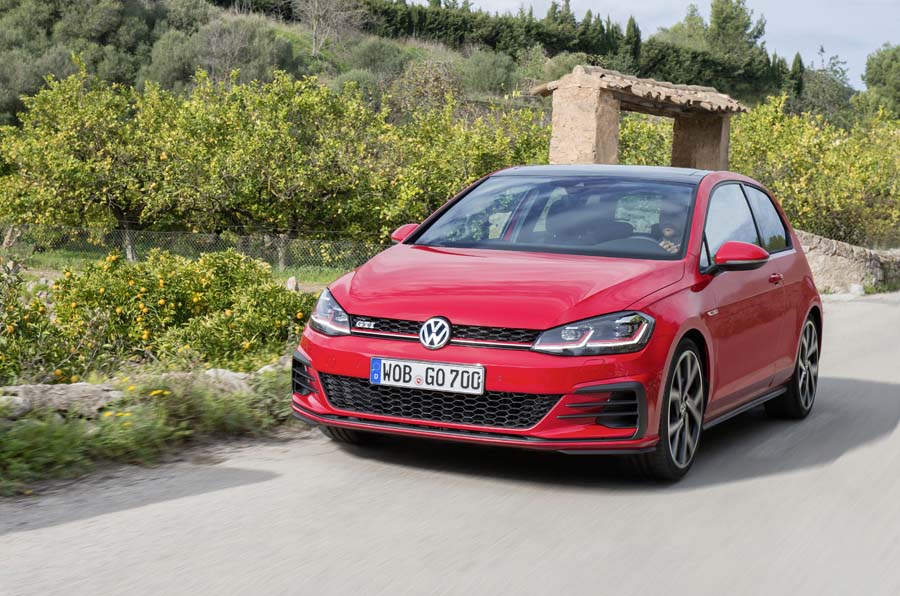Hyundai wades into the hot hatchback battle in earnest with its i30 N. Given this is the company's first proper attempt at a hot hatch, it would have been acceptable if Hyundai had simply come up with something that was an intriguing alternative to the mainstream. But, with the invaluable know-how of former BMW M boss Albert Biermann in the mix, what Hyundai has delivered here is a front-drive hot hatch that's so good, it has to be given serious consideration as a potential winner of class honours.
In the metal
While not exactly a beautiful car, the standard Hyundai i30 is nevertheless inoffensively handsome and European enough to be pleasing on the eye. The company hasn't gone wild for the visuals of this N performance version, like Honda did with its unreserved Civic Type R, but there are enough appealing intricacies and a general overall 'rightness' to the car's shape and stance that combine to make the i30 N a real winner.
The brand's signature, motorsport-themed, pale Performance Blue paint helps, as it sets off much of the black detailing around the car, but we also particularly like the aero flicks on the rear flanks, the red pinstripes in both the front splitter and rear diffuser (the latter flanked by two oval exhaust pipes), the meaner LED headlights with their black bezels, the distinctive triangular high-level brake light and the gorgeous design of the 18- or 19-inch five-spoke alloy wheels that are offered.
The i30 N sits wonderfully foursquare on the road, giving it a real presence without it being in the slightest bit OTT. Granted, some critics on the launch actually went the other way and said it looked boring, but come on, apart from that aforementioned Honda, which other hot hatches are visually outlandish? Both the Volkswagen Golf GTI and Peugeot 308 GTi look reserved, and it's against these rivals which the i30 N must compete. So, all things considered, we heartily approve of the Hyundai hot hatch's aesthetics.
It's the same story inside, where the regular car's sober but largely well-made interior has been subtly improved by the addition of some key performance motifs. There are smarter, N-logoed dials in the blue-lit cluster, a quintet of white, yellow and red-sequenced shift-up lights housed in the binnacle, LEDs around the rev counter that extinguish as the oils warm through (this is very E46 BMW M3, by the way), a chunkier, round knob for the gearshift, a fat steering wheel with perforated leather hand-holds, additional track-related screens in the eight-inch infotainment display and a set of N-branded leather-and-suede sports seats that are both comfortable and supportive.
Crucially, the driving position is spot on, and the feel of much of the switchgear is of the highest quality, so overall the i30 N's cabin is a fantastic place to spend some time - even if there's a fillet of hard, unyielding trim slap-bang in the middle of the fascia and some scratchier plastics hidden lower down on the sides of the transmission tunnel. Also, one note on practicality: models with the rear strut brace lose a tiny bit of boot space (14 litres, to be precise), because it's mounted above the load bay floor and is therefore in plain sight at the base of the seat backs.
Of course, we've not touched on the two-tier i30 N performance grades on offer, nor some of the most obvious buttons mounted on that three-spoke steering wheel. The 'basic' model, for want of a better phrase, comes with 250hp and 353Nm from its turbocharged 2.0-litre four-cylinder petrol motor, that torque figure rising to 378Nm on a time-limited overboost phase. It gets 18-inch wheels with Michelin Pilot Super Sport tyres, 17-inch front and 16-inch rear brake discs (ventilated at the front), and a Torque Vectoring System that uses said brakes on the front axle to trim the car's line while cornering. It also comes with Electronically Controlled Suspension (ECS), with three settings for the dampers from Comfort through to N's Sport+, plus Launch Control and Rev Matching functions for keener drivers.
The i30 N Performance Pack, though, which we've tested here, adds 25hp for a peak output of 275hp, has 19-inch wheels which are shod in a compound of Pirelli P-Zero rubber that's unique to the Hyundai, enlarges the brakes by an inch on each axle and adds an Electronic Limited Slip Differential (e-LSD), which is a clutch-based diff that can split torque individually to the front wheels. It also gets sundry other items, like electrically operated front seats and so on, but another big tick in the 'Pros' column is the Active Variable Exhaust System. This ramps up the noise in full-on N mode to make the car its most aurally appealing.
There are two blue buttons hanging off the lower edges of the steering wheel's arms, one marked Drive Mode and one with a chequered flag motif. The one on the left cycles the car through Eco, Normal and Sport set-ups. The one on the right puts it into its most aggressive 'N' mode, or alternatively into a Custom setting where you can tweak the steering, suspension, ESC, exhaust and throttle response. Just above the N switch is a button marked Rev, which simply means you can pop the rev-matching function of the car on or off incredibly easily, rather than having to delve into sub-menus on the infotainment, as happens in the Civic Type R. It's a stroke of genius on Hyundai's part to make both N mode and the rev-matching so readily accessible to the driver.
Anyway, the long and short of all this is that, while we think the base i30 N is fine, you're really going to want the Performance Pack if you're going to invest in this brave new venture from Hyundai, and here's why...
Driving it
Let's get the negatives out of the way first: the Hyundai i30 N is not perfect. The marque still can't get the hang of multi-mode, electronically-assisted power steering. Now, being as fair as possible, the i30 N has by far the best feel, weighting and consistency of any Hyundai steering we've yet tried, as it's in the main excellent, but it still lacks the final few degrees of feedback and nuance that you want when fully loading it up on track. The Hyundai also has a fairly obvious lack of lift-off oversteer, which could possibly be a criminal offence in a hot hatch such as this, if it weren't for the fact that the e-LSD-equipped front axle is an absolute sensation.
To get the i30 N PP to wash into fun-sapping understeer, you need to have got its Pirelli tyres exceedingly hot and then you need to plough into a bend with a colossal amount of excessive speed; in essence, what this means is that you need to act like a total clot at the end of a lengthy track session to even think about making the front end of the car push on. Otherwise, what you have here is a performance five-door that boasts a nose that will snuffle out apexes in much the same way a pig might unearth truffles in a northern Italian forest. The diff isn't a proper mechanical 'slipper', but it acts so fast, so unobtrusively and so brutally effectively that you can hold a quite startling amount of velocity into, through and out of a corner. The clever ECS dampers also negate dive under braking, roll during lateral g-loads and pitch upon acceleration to keep the i30's body admirably flat during rigorous kinematic work-outs, while the incredible all-round stability of the car is utterly remarkable.
All of the above amounts to a hatchback that's a complete riot on track. Sure, back off the throttle in the corners and the rear end won't swing out, but instead the e-diff will do its thing and magically tighten the Hyundai's line, just when you thought all hope of grip was lost. A few hot laps of Vallelunga circuit in Italy proved this car's link to the Nürburgring - it was honed there extensively during development, hence the N nomenclature - is entirely justifiable. The i30 N is brilliant in such an environment.
Better still, the i30 N can translate its deeply impressive track handling performance out onto the harsh, cratered realities of pockmarked roads, where it resists torque-steer, diff-swerve and camber-hunting with aplomb. Having the ECS dampers in N mode does make the i30 perhaps a little too harsh for the extremes of a rucked-up surface, but you can pick and choose settings in the Custom drive mode that allows you to team the engine's naughtiest noises and the sharpest throttle response to softer shocks for undulating country roads. The net result? A blindingly fast, highly involving road car that's easily more fun to drive than a Volkswagen Golf GTI.
It also sounds tremendous for a four-cylinder turbo motor. The raucous exhaust does much of the work, popping and banging on the overrun and during downshifts, but the engine itself manages to add some meaningful notes to the mechanical symphony. It's that active exhaust of the Performance Pack which truly makes the car's music great, of course, so it's yet another reason to pick the 275hp car over the 250hp base machine. And regarding other dynamic concerns, the i30 has a lusty engine that has more than enough grunt for a circa 1,450kg hatch like this. It has a fine, tight-of-throw six-speed manual transmission, it has one of the best automated rev-matching functions we've ever sampled when it's in full N mode and the monster brakes - developed in-house, using Hyundai's own knowledge of high-performance stoppers - provide excellent retardation and are impressively resistant to fade.
Luckily, driven in its Normal set-up with the dampers at their most pliant, the i30 N is as plush an everyday car as you could possibly hope for. The ride quality is excellent on the 19-inch wheels and the suppression of most major noise contributors is first rate; sometimes, extremely poor surfaces introduce a lot of tyre roar, but it's not often that this occurs. With its torque-rich midrange and good visibility out, driving the i30 N at a steady cruise on the motorway is no hardship at all. Is it as polished as a Golf GTI? Perhaps not quite, but it's so close to the Volkswagen for refinement that it allows the i30 N to deliver a knockout blow when it comes to the crunch on chassis dynamics. And given Volkswagen has been doing this sort of thing for four decades and Hyundai is just starting out, the magnitude of that conclusion cannot be underestimated.
What you get for your money
Aside from the obvious magnificent technical make-up of the car, all i30 Ns come with eight-inch touchscreen satnav incorporating infotainment that bundles up Apple CarPlay and Android Auto as standard, LED head- and tail-lights, adaptive cruise control, keyless entry and go, and dual-zone climate control. Even specified up with the Performance Pack, which is likely to be at least €4,000 on top of the price of the base car here when figures are confirmed, the Hyundai should undercut a standard 230hp Volkswagen Golf GTI by a few Euros. OK, this is potentially a €40,000 performance car without any heritage from a company known for great value first and foremost, so we're not exactly talking cheap - but then the absolute brilliance of the i30's chassis should shine out from the moment you start test-driving it, so it will probably feel something of a bargain. Plus, the N qualifies for the same five-year, unlimited distance warranty as any other Hyundai, which makes it a sound ownership proposition. Hyundai Ireland is expected to announce pricing in the coming weeks ahead of the i30 N's launch here in 2018.
Summary
The i30 N is amazing. Truly, defiantly amazing. OK, having Biermann on board was bound to lead to some good things, but by his own admission, when he joined Hyundai from BMW M in 2014, he didn't have a lot of experience of front-wheel drive cars. Also, while the regular i30 is a fine everyday conveyance, exciting to drive it is not. And the marque has no credible performance history of which to speak, save for its burgeoning reputation in the World Rally Championship with the i20.
Yet what the company has given us in the i30 N is a new hot hatch that isn't just a credible contender in the marketplace; it's actually so thoroughly accomplished that it feels like Hyundai has been doing this sort of thing for years. Hugely thrilling and incredibly relaxing in equal measure, the i30 N is a coruscating, scintillating start to the company's N performance brand - and it's one of the best hot hatchbacks you can buy right now. Possibly even the best, if you want a top-level front-drive chassis but understated looks. The Hyundai i30 N is outrageously good.
































